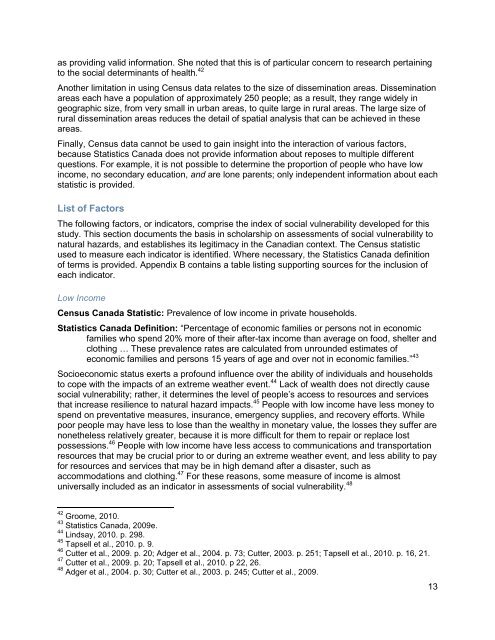Lunenburg Part 2 - Section 5 - Social Vulnerability - August 30.pdf
Lunenburg Part 2 - Section 5 - Social Vulnerability - August 30.pdf
Lunenburg Part 2 - Section 5 - Social Vulnerability - August 30.pdf
Create successful ePaper yourself
Turn your PDF publications into a flip-book with our unique Google optimized e-Paper software.
as providing valid information. She noted that this is of particular concern to research pertaining<br />
to the social determinants of health. 42<br />
Another limitation in using Census data relates to the size of dissemination areas. Dissemination<br />
areas each have a population of approximately 250 people; as a result, they range widely in<br />
geographic size, from very small in urban areas, to quite large in rural areas. The large size of<br />
rural dissemination areas reduces the detail of spatial analysis that can be achieved in these<br />
areas.<br />
Finally, Census data cannot be used to gain insight into the interaction of various factors,<br />
because Statistics Canada does not provide information about reposes to multiple different<br />
questions. For example, it is not possible to determine the proportion of people who have low<br />
income, no secondary education, and are lone parents; only independent information about each<br />
statistic is provided.<br />
List of Factors<br />
The following factors, or indicators, comprise the index of social vulnerability developed for this<br />
study. This section documents the basis in scholarship on assessments of social vulnerability to<br />
natural hazards, and establishes its legitimacy in the Canadian context. The Census statistic<br />
used to measure each indicator is identified. Where necessary, the Statistics Canada definition<br />
of terms is provided. Appendix B contains a table listing supporting sources for the inclusion of<br />
each indicator.<br />
Low Income<br />
Census Canada Statistic: Prevalence of low income in private households.<br />
Statistics Canada Definition: “Percentage of economic families or persons not in economic<br />
families who spend 20% more of their after-tax income than average on food, shelter and<br />
clothing … These prevalence rates are calculated from unrounded estimates of<br />
economic families and persons 15 years of age and over not in economic families.” 43<br />
Socioeconomic status exerts a profound influence over the ability of individuals and households<br />
to cope with the impacts of an extreme weather event. 44 Lack of wealth does not directly cause<br />
social vulnerability; rather, it determines the level of people’s access to resources and services<br />
that increase resilience to natural hazard impacts. 45 People with low income have less money to<br />
spend on preventative measures, insurance, emergency supplies, and recovery efforts. While<br />
poor people may have less to lose than the wealthy in monetary value, the losses they suffer are<br />
nonetheless relatively greater, because it is more difficult for them to repair or replace lost<br />
possessions. 46 People with low income have less access to communications and transportation<br />
resources that may be crucial prior to or during an extreme weather event, and less ability to pay<br />
for resources and services that may be in high demand after a disaster, such as<br />
accommodations and clothing. 47 For these reasons, some measure of income is almost<br />
universally included as an indicator in assessments of social vulnerability. 48<br />
42 Groome, 2010.<br />
43 Statistics Canada, 2009e.<br />
44 Lindsay, 2010. p. 298.<br />
45 Tapsell et al., 2010. p. 9.<br />
46 Cutter et al., 2009. p. 20; Adger et al., 2004. p. 73; Cutter, 2003. p. 251; Tapsell et al., 2010. p. 16, 21.<br />
47 Cutter et al., 2009. p. 20; Tapsell et al., 2010. p 22, 26.<br />
48 Adger et al., 2004. p. 30; Cutter et al., 2003. p. 245; Cutter et al., 2009.<br />
13














